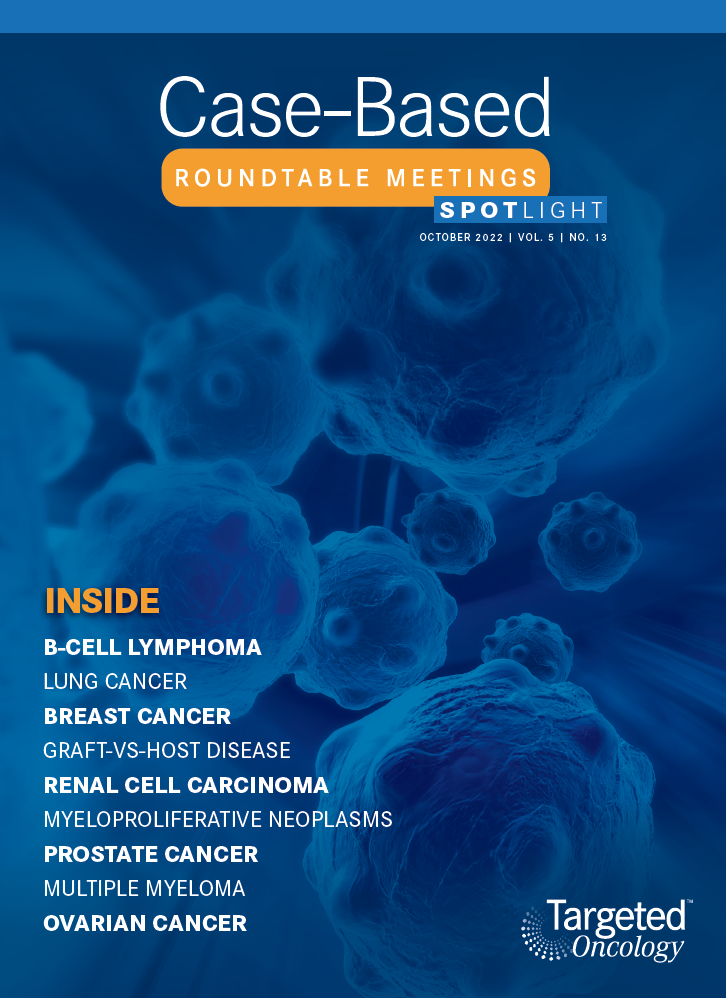Clinical Commentary: Testing and Targeting for NTRK Fusions in Non–Small Cell Lung Cancer
Mark A. Socinski, MD provides insight on biomarker testing to identify patients with NTRK gene fusion-positive non–small cell lung cancer.

Mark A. Socinski, MD

Strategies for Biomarker Testing in NSCLC
The strategy of a broad molecular panel–based next-generation sequencing [NGS] approach minimizes tissue use and wastage.1 It would also identify where a driver mutation, such as an NTRK fusion, is a key component to improve patient care. For the fusions, [you must be] sure your NGS platform includes RNA analysis because it does increase and maximize the detection of fusion events. [The molecular panel does] comment on if the tissue gathered [is] insufficient, so either repeat biopsy or plasma testing should be done.
[Clinicians] should get the results of molecular testing before administering first-line immunotherapy. It is true in this oncogenic driver subset that PD-L1 expression may be elevated, but targeted therapy clearly takes precedence for the oncogenic driver over immunotherapy in this patient population.
Those patients who have PD-L1 expression greater than 1% [and] a targetable driver oncogene molecular variant should receive first-line targeted therapy for that oncogene. If you have a target, use a targeted therapy because in this population, first-line immunotherapy is not a very effective therapy, and the targeted therapy response rates and durability of response are, in a way, much better than immunotherapy in these populations.
Ignore PD-L1 [expression] until you know the results of broad comprehensive molecular testing. The National Comprehensive Cancer Network [NCCN] defines broad molecular profiling as testing that identifies EGFR, KRAS, ALK, ROS1, BRAF, NTRK1/2/3, MET exon 14 skipping, RET, and PD-L1 expression in either single assay or a combination of a limited number of assays and can optimally identify these biomarkers again. All these agents have FDA-approved therapies; in some cases, several therapies.
In the NCCN recommendations, [there is a] tiered approach based on looking for the more common biomarkers first and the less common ones sequentially. They say it’s acceptable, but to be honest, it’s not acceptable to me. I don’t know why you would tier your approach [when you can] do a broad platform and get them all at the same time in this setting.
Recommended Biomarker Testing in NSCLC
My standard platform for liquid-based testing is the Guardant360 CDx assay. That’s what I’ve been using historically for liquid-based testing. There are others who do that, but I can’t speak authoritatively about what may be the best platform for these sorts of things. I also don’t get much pushback for doing both tissue and blood testing, because you never know whether the tissue is going to be sufficient [for the test].
Time is of the essence [for] these patients, and we all know there are cases that are highly symptomatic. So either the patient or their family is nervous, and you’ve got to do something. The [procedure] is to give a cycle of chemotherapy without immunotherapy in the first cycle, and it buys you 3 weeks. I don’t think there’s any downside [to] that if you feel like you need to do something [sooner rather than later].
How to Handle an Insufficient Amount of Tissue for Biomarker Testing
The pulmonologist [at my cancer center] tends to do less invasive procedures, which results in less tissue [for genetic testing]. Part of the problem [with] being a medical oncologist is we often aren’t involved in the decision-making about what procedure is being done, but I’m involved in it. I tend to use interventional radiology and ask them to give core biopsies and a fine-needle aspiration to the extent they feel it’s safe [for the patient]. We don’t get a lot of quantity-not-sufficient [QNS] results, but occasionally, it does happen. So we often get rescued by the liquid biopsy in this setting because of that.
Incidentally, I think bronchoscopy is the [least useful] diagnostic test in lung cancer in terms of getting tissue. Endobronchial ultrasound bronchoscopy is OK, but straightforward bronchoscopy is often futile in terms of getting every bit of information you need. We did a study when I was at UPMC [University of Pittsburgh Medical Center in Pennsylvania] where we had 7 interventional radiologists and the rate of getting sufficient tissue was volume dependent, as most things in medicine are, but those who did a lot of biopsies were more likely to get sufficient tissue. In comparison, if you did 1 or 2 quarters, you had a rate of QNS [results] that was much higher than the [clinicians] doing them more frequently.
It’s not that we want to point out they’re doing a bad job; it’s more that they need to [take] some training from the [clinicians who get] tissue all the time in terms of their approach. We want to raise the level for everybody and make sure that those [clinicians] who [attain] marginal [results]…can fix…that kind of thing. It’s more of an effort to get [clinicians] to a standard that’s acceptable. We have gone to the point of scheduling patients on days that particular [clinicians] are scheduled to do the biopsies. We won’t schedule them on days we know someone is there who’s less likely to get sufficient tissue.
Utilizing Liquid Biopsies in Various Patients
The problem with liquid biopsies is that if you don’t find anything, you can’t trust it, because we don’t understand tumor shedding of tumor DNA. The other issue I try to get a sense of is tumor volume. It’s not an objective, quantifiable [measurement]. It’s a gut reaction if [the patient has] stage IV disease based on multiple small pulmonary nodules that are bilateral vs if there are liver metastases, bone metastases, pleural effusions, etc, at a higher volume of tumor. I always feel more confident about a liquid biopsy in the latter vs the former, where you might miss it.
You must also realize that [testing] blood is only good, and you can believe [it], if you find something. If you don’t find something, I still think you must [test] tissue, and if that includes a repeat biopsy, so be it. The problem is [that] by the time you schedule [the test] and get the results [which come back] 3 to 4 weeks later, which is not very appealing to many patients. If you’re in that situation, you can always start with a couple of cycles of chemotherapy without immunotherapy.
Efficacy of Larotrectinib in NTRK Fusion– Positive NSCLC
In the NCCN guidance, an oncogenic driver like an NTRK fusion prompts PD-L1 expression. Even if this patient had high PD-L1 expression, the proper thing to do is target with either entrectinib [Rozlytrek] or larotrectinib [Vitrakvi], and I would ignore the PD-L1 expression. Again, PD-L1 expression means nothing until you know the molecular makeup, and if you have a target, a driver like NTRK, you need to target the driver.
[There were several phase 1 and phase 1/2 trials that examined the efficacy of larotrectinib.] In the analysis of those studies, 218 patients with nonprimary central nervous system [CNS] metastases had TRK fusion– positive [disease].2 The primary end point in these trials was overall response rate [ORR], and secondary end points included duration of response [DOR], progression-free survival [PFS], overall survival [OS], and safety. There were 21 tumor types involved in these studies, and the dominant ones were [in] patients with soft tissue sarcoma, infantile fibrosarcoma, and thyroid [disease].
[Patients included in the trial had] mostly good performance status, but about 10% had CNS metastases at the time of enrollment. Most were previously treated, but the most common NTRK fusions were either NTRK1 or NTRK3, with very few NTRK2 fusion–positive tumors.
The ORR among all patients was 75%, and ORR of patients with CNS metastases at baseline was 63% among 10 patients.3 Most responses were partial responses, although 22% [of patients had] complete responses. The 20 patients with NTRK-positive lung cancer had an ORR [similar to] the general population at 73%; however, most of those [patients had] a partial response at 67% [n = 10]. There was a low rate of progressive disease at 7%, and the ORR in patients with baseline CNS metastases was [also similar]. Across all these tumor types, there was substantial activity of NTRK inhibition in patients with an NTRK fusion in their tumor.
The patients with NTRK fusion–positive lung cancer [had] median follow-up care of about 17.4 months, but many of these patients [involved in this analysis] were on treatment for a long time, some with CNS metastases and some without. [In the average data set] there was a median DOR of 49.3 months [95% CI, 27.3-NE]. In comparison, for patients with TRK fusion–positive lung cancer, the median DOR was 33.9 months and median PFS was 35.4 months. Median OS was not reached overall, but there was a high efficacy when targeting TRK in this population, with a median OS of 40.7 months for patients with lung cancer.
Safety Outcomes of Larotrectinib
Grade 3 and 4 treatment-emergent adverse events [TEAEs] and treatment-related adverse events [TRAEs] were in the low single digits for the most part, with most toxicities either grade 1 or 2. [Some of the most common TEAEs of any grade included] cough [34%], liver function abnormalities [33%], diarrhea [32%], fatigue [28%], nausea [28%], and dizziness [26%]. However, most of the grade 1, 2, 3, or 4 TRAEs, in totality, were reported [in] about 18% of patients, but in the lung cancer subset, there were no surprises or new safety signals reported.
When comparing larotrectinib and entrectinib, it’s important to remember that entrectinib is also approved in the ROS1-positive setting. Moreover, dose reductions due to AEs are more common with entrectinib [at 29% compared with 8% for patients on larotrectinib].4 However, discontinuations were 9% in both drugs, and the most common AEs overlap to a certain extent [including fatigue, dizziness, and cough]. Moreover, both drugs come with warnings for [potential] CNS effects and skeletal fractures.
REFERENCES:
- Ettinger DS, Wood DE, Aisner DL, et al. Non-small cell lung cancer, version 3.2022, NCCN clinical practice guidelines in oncology. J Natl Compr Canc Netw. 2022;20(5):497-530. doi:10.6004/jnccn.2022.0025
- Drilon A, Laetsch TW, Kummar S, et al. Efficacy of larotrectinib in TRK fusion-positive cancers in adults and children. N Engl J Med. 2018;378(8):731-739. doi:10.1056/NEJMoa1714448
- Drilon A, Tan DSW, Lassen UN, et al. Efficacy and safety of larotrectinib in patients with tropomyosin receptor kinase fusion-positive lung cancers. JCO Precis Oncol. 2022;6:e2100418. doi:10.1200/PO.21.00418
- Important safety information and indication. Rozlytrek. 2022. Accessed September 16, 2022. https://bit.ly/3xvSYd0

Survivorship Care Promotes Evidence-Based Approaches for Quality of Life and Beyond
March 21st 2025Frank J. Penedo, PhD, explains the challenges of survivorship care for patients with cancer and how he implements programs to support patients’ emotional, physical, and practical needs.
Read More